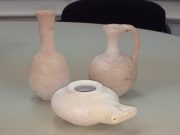Online Store
Home > Israeli Antiquity Authority
Category
Showing 1–16 of 44 results
-
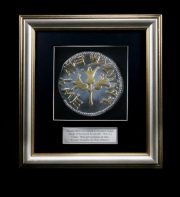
Ancient Silver Coin Replica
$150.00 Add to cartAncient Silver Coin, minted in Jerusalem (copy). Sheqel of the Jewish revolt against the Romans (66-70 AD). In the center: Three Pomegranates on Stem. Around, in Hebrew: “Jerusalem the Holy”.
Silver Sterling 925 plated.
Coin size: 4.4″.
Picture size: 11″ X 10″.
High quality frame. Nice box. -
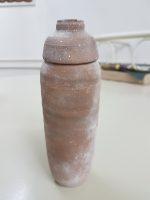
DSS Jar
$11.00 Add to cartPottery Replica of a DSS Jar. Including a rolled Replica of the Scroll of “The Ten Commandments”.
Size: 6 inches high. -
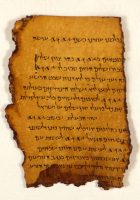
DSS Photographic Reproduction – Psalm 126
$46.00 Add to cartThis text of the Dead Sea Scrolls includes Psalm 126 and is dated to 30-50 AD. The psalm is one of 15 psalms headlined as “Song of Ascents”, describing the yearning for redemption and return to Zion.
The reproduction is printed on high quality canvas, stretched on wooden frame. Ready to hang on the wall. Includes English Explanation about the scroll.
Size: 12″ X 16.5″.
-

DSS Photographic Reproduction – Psalm 133,137,138,141,144
$82.00 Add to cartThis fragment of the Psalms Scroll is part of one of the longer texts of the Dead Sea Scrolls. The scroll contains twenty eight incomplete columns of text, five of which are represented here including the text of psalms 133, 137, 138, 141, 144 and two non-canonical psalms. Psalm 133 opens with the famous phrase:
“Behold, how good and how pleasant it is for brethren to dwell together in unity”.
The reproduction is printed on high quality canvas, stretched on wooden frame. Ready to hang on the wall. Includes English Explanation about the scroll.
Size: 9″ X 31.5″.
-
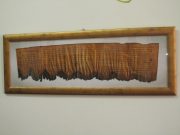
DSS Photographic Reproduction Premium – Psalm 133,137,138,141,144
$205.50 Add to cartupgraded: New HD digital photograph, on light grey background, high quality wooden frame with glass.
This fragment of the Psalms Scroll is part of one of the longer texts of the Dead Sea Scrolls. The scroll contains twenty eight incomplete columns of text, five of which are represented here including the text of psalms 133, 137, 138, 141, 144 and two non-canonical psalms. Psalm 133 opens with the famous phrase: “Behold, how good and how pleasant it is for brethren to dwell together in unity”. Includes English Explanation about the scroll.
Size: 12″ X 33.5″.
-
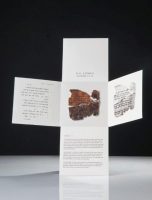
Folder with a Photographic Reproduction from the Scroll of Genesis
$22.25 Add to cartA digigraphic print, Museum quality, of the Scroll of Genesis, Chapter 1:1-11.
The print comes in a folder, including a transcription and a translation of the Biblical Text into English. Includes an explanation about the Scroll.
Highly recommended! -
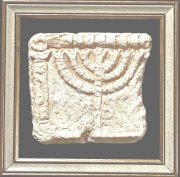
Menorah Replica
$82.00 Add to cartFramed replica of a seven armed candelabra (Menorah). The Menorah is an ancient Jewish symbol that was first described in the Book of Exodus, and was eventually placed by King Solomon in the Temple of Jerusalem ca. 3,000 years ago. The symbol, although being Jewish originally, is meaningful to many Christians as well.
The replicas have been hand made by a senior conservator of the IAA.
The replica is on a black velvet background with a frame of off-white and gold.
Size, including frame: 14″ X 14″.
-
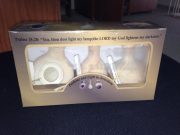
Perfume and Light in Jerusalem, Second Temple period
$19.50 Add to cartThree pottery replicas in a box: A Pear-shaped Bottle, a Juglet, an Oil Lamp.
The originals were found in Jerusalem and date back 2,000 years, to the First Century CE. The bottles were used for perfume. Perfumes were very precious in ancient times, and were used for therapy, ritual and cosmetic purposes. The bottles were always small, with a narrow neck and a broad rim.
Oil lamps were commonly used in ancient times. Most were relatively simple, others, heavily decorated. This oil lamp is a replica of a typical First Century oil lamp from Jerusalem.
Size with box: 3″ x 8″ x 4.5″.
-
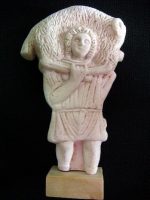
Replica of the Statue of the Good Shepherd
$69.50 Add to cart4th- 5th Century A.D.
“I am the good Shepherd” (John 10:11).
The image of the shepherd carrying a lamb on his shoulders is one of the earliest Christian motifs, symbolizing Jesus’ care for his flock of believers, it is based on his parable of a shepherd who searches for a lost sheep: “If one of you has a hundred sheep and loses one of them, does he not leave the ninety-nine in the open pasture and go after the missing one until he has found it? How delighted he is then! He lifts it on to his shoulder…” (Luke 15:5).The statue, made of marble, was found in Gaza.
Original Statue is exhibited at the Rockefeller Museum, Jerusalem, Israel.
Original Statue Measurements: height – ca. 24″; Max width – ca. 14.5″. -
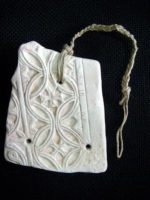
Replica: Engraved Anchor
$51.50 Add to cartThe stone anchor was discovered in the ancient anchorage of Yavneh. It was probably used on a small fishing or trading vessel (5th–6th centuries CE) that was owned by a Christian.
The engraved stone slab was originally part of a church iconostasis (a low wall decorated with Christian symbols) that partitioned the main hall from the holy altar in the center of the church. After becoming redundant it was selected by a local fisherman or trader for use as an anchor. It seems that this section of the iconostasis was chosen due to the two crosses engraved in it. To convert it into an anchor, three perforations were made in the slab: the top hole for tying rope, and the two bottom perforations for inserting wooden logs for gripping the seabed.
The use of an item from the holiest area of the church, in conjunction with its crosses, as an anchor is highly symbolic, for the anchor is one of the most important safety devices on a boat and in itself is a symbol of hope and stability.Original Anchor Measurements: Height – ca. 22″; Max width – ca. 18.5″.
-
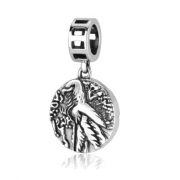
Sterling Silver Charm/ Pendant – Half a Sheqel – Ancient Coin Replica
$23.19 Add to cartA Silver Half Shekel. Minted in Tyre.
This coin was customarily used to pay the half shekel head-tax to the Temple in the Second Temple period.
At the time the Jerusalem Temple stood, every Jew was commanded to donate a half shekel to the Temple. This sum allowed all Jews, wealthy or poor, to contribute in the building’s maintenance, and for the purchase of the public sacrifices.
-
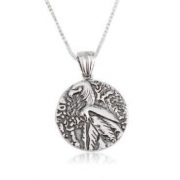
Sterling Silver Pendant – Half a Sheqel – Ancient Coin Replica
$32.60 Add to cartA Silver Half Shekel. Minted in Tyre.
This coin was customarily used to pay the half shekel head-tax to the Temple in the Second Temple period.
At the time the Jerusalem Temple stood, every Jew was commanded to donate a half shekel to the Temple. This sum allowed all Jews, wealthy or poor, to contribute in the building’s maintenance, and for the purchase of the public sacrifices.
-
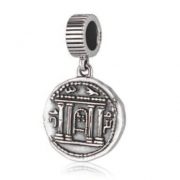
Sterling Silver Charm/ Pendant – Temple Image – Ancient Coin Replica
$23.19 Add to cartSilver Sela (Tetradrachm)– from the Bar Kokhba Revolt, 132–135 C.E.
Obv.: Facade of the Temple in Jerusalem. Above Temple, a rosette. Around, paleo-Hebrew inscription: “Shimon”.
Rev: The ‘Four Species’ connected to the Feast of Tabernacles, surrounded by inscription: “For the freedom of Jerusalem”.
-
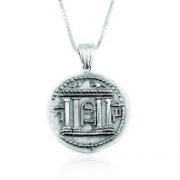
Sterling Silver Pendant – Temple Image – Ancient Coin Replica
$32.19 Add to cartSilver Sela (Tetradrachm)– from the Bar Kokhba Revolt, 132–135 C.E.
Obv.: Facade of the Temple in Jerusalem. Above Temple, a rosette. Around, paleo-Hebrew inscription: “Shimon”.
Rev: The ‘Four Species’ connected to the Feast of Tabernacles, surrounded by inscription: “For the freedom of Jerusalem”.
-
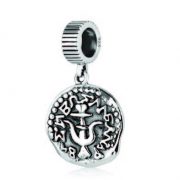
Sterling Silver Charm/ Pendant – Widow’s Mite – Ancient Coin Replica
$21.10 Add to cart“Widow’s Mite”: Coin minted in Jerusalem, under the Hasmonean leader and High Priest John Hyrcanus I, for the Seleucid king Antiochus VII.
The coin depicts an inverted anchor, and the inscription “Of King Antiochus, Benefactor”. The reverse of the coin depicts a lily, symbol of Jerusalem and one of the decorations of the capitals standing at the entrance to the First Temple.
contact us

